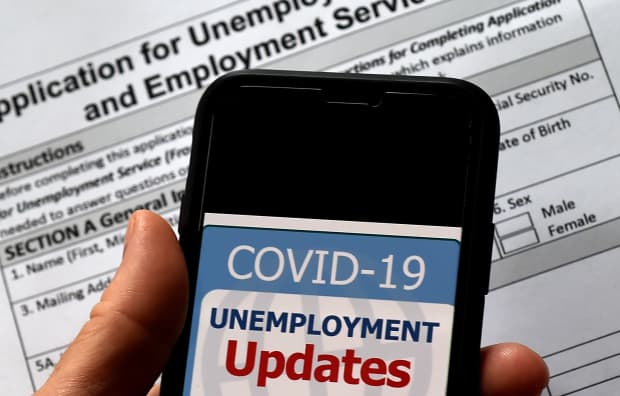This post was originally published on this site

Unemployment in the U.S. is in danger of rising again because of the record coronavirus outbreak.
olivier douliery/Agence France-Presse/Getty Images
The numbers: New applications for U.S. unemployment benefits fell in late November for the first time in three weeks, probably due in part to the Thanksgiving holiday.
The number of people applying for benefits, however, is still quite high and the latest decline is unlikely to dispel fresh worries about rising layoffs and a slowdown in hiring after a record wave of coronavirus cases.
Initial jobless claims dropped by a seasonally adjusted 75,000 to 712,000 in the seven days ended Nov. 28. Economists polled by MarketWatch had forecast initial jobless claims to total 780,000.
Another 288,701 people applied for benefits through a temporary federal-relief program that expires at the end of the year, the government said Thursday.
The combined number of new state and federal jobless claims still hasn’t dropped below 1 million a week since the start of the pandemic more than eight months ago.
What happened: The decline in jobless claims last week may have been exaggerated by Thanksgiving. Some people who lose their jobs put off filing their claims during holidays until the following week.
New jobless claims had fallen steadily through the summer and fell to a pandemic low of 711,00 early in November, but the decline came to a halt after the coronavirus exploded again.
The number of continuing jobless claims administered by the states, meanwhile, sank by 569,000 to a seasonally adjusted 5.52 million in the week ended Nov. 21. That’s a new pandemic low.
Adding to the total, continuing claims funded by a temporary federal program rose by an unadjusted 59,732 to 4.57 million in the week ended Nov. 14, the latest data available. These claims has more than tripled since August as people who’ve exhausted state benefits shift to the federal program.
In normal times, continuing claims are closely aligned with the number of people who are actually receiving unemployment benefits, but the data has become less accurate during the pandemic.
A new study by a federal watchdog agency concluded that continuing claims have been inflated by fraud, double counting, inconsistent state reporting and other problems.
Read: Jobless claims inflated, GAO finds, and many unemployed were underpaid
Some economists have long questioned the accuracy of jobless claims because other government data indicates unemployment is significantly lower.
The total number of people receiving benefits from eight separate state and federal programs, for instance, was reported at an unadjusted 20.16 million as of Nov. 14.
Yet the government’s monthly jobs report indicated that a far smaller 11.1 million people were unemployed in October.
See: MarketWatch Coronavirus Recovery Tracker
Big picture: The flood of new coronavirus cases has forced some businesses to lay off workers and put off hiring. In other cases workers fearful of catching the virus have been absent, making it harder for companies to operate at full tilt.
Read: Absenteeism, shutdowns’ tied to coronavirus spike hurt U.S. businesses again
The damage to the labor market so far has been relatively small compared to the spring, but if the viral outbreak gets any worse it’s likely to stunt the economic recovery and cause more misery for the unemployed
Market reaction: The Dow Jones Industrial Average DJIA, +0.20% and S&P 500 SPX, +0.17% SPX, +0.17% were set to open higher in Thursday trades.

